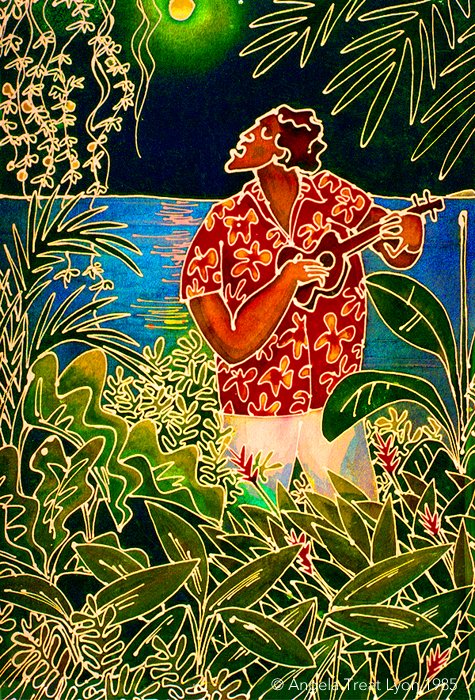
Hanalei Moon – Dyes and Batik on Paper 40″ x 30″ – sold
Batik: a method of dyeing cloth which involves the use of removable wax to repel the dye on parts of the design where dye is not desired. Batik originated in indonesia.
“The word batik is Javanese, and has been loosely translated as “good points or dots,” referring to the tiny dots in Indonesian patterns that give them a lively quality and that show a mastery of technique.*
“A standard definition of the medium of batik is that it is a way of coloring fabric with successive dye baths, producing a design by using wax to resist dyes.*
“Each design is hand-drawn with melted wax using a tjanting tool.
“A tjanting has a small brass bowl at the end of a handle; a tiny spout allows the melted wax to run onto the fabric.*”
One “employs beeswax as a resist and begins with the lightest colors continuing through the darkest colors.*”
HOW I USE BATIK
Instead of cloth, I use heavy-duty, cold-pressed Arches watercolor paper. I USE an iron to melt out the wax instead of boiling, chemicals or caustic sodas. And I use a tjanting tool to draw the design, then paint in the color dyes into the waxed areas.
Layer by layer, the color is built up to acheive as brilliant an image as I can attain. I did a series of Hawaiian Legends – the photos of which I will one day dredge up from under all my files; but in the kind-time, there are a couple on this page to whet your whistle.
I started doing batiks in the early 1980s in the time period between when I stopped making pots and started carving stone.
(*excerpts taken from the article written with information from the excellent batik-on-cloth artists Cathy Haight, Bambang Otoro and Dorothy “Bunny” Bowen in the Online Collector’s Guide)
